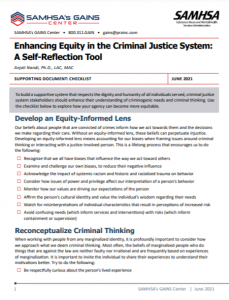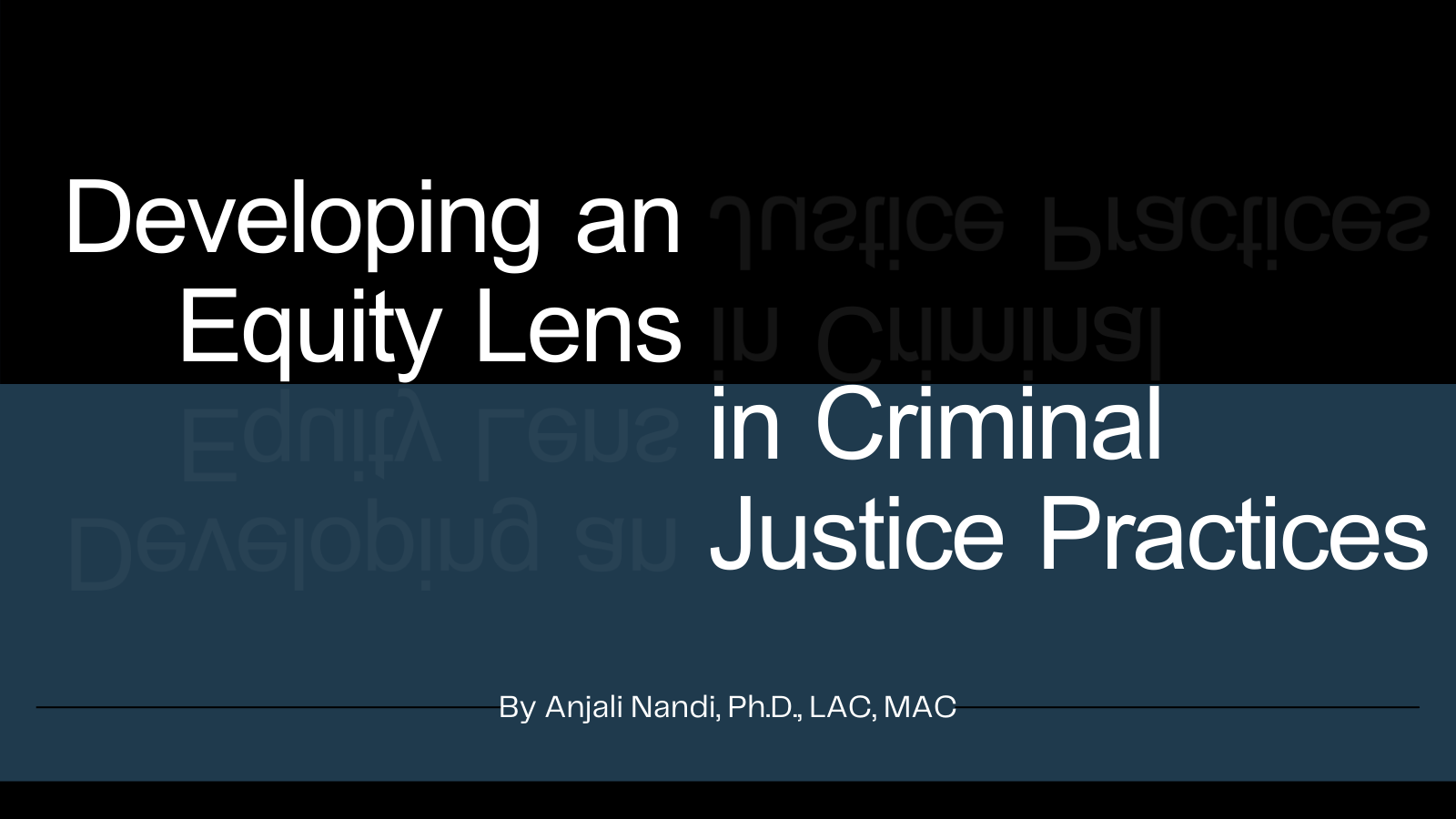By Anjali Nandi, Ph.D., LAC, MAC
Evidence of racial inequity abounds in our country, but among the most alarming and detrimental to the fabric of our society is found in the criminal justice system. There are over 2.3 million people incarcerated in America, and approximately 60 percent of these are African American and Latino, despite African American and Latino individuals representing less than 35 percent of the general population.[1] [2] These racial disparities exist at every level of the system, from policing, to enforcement, to sentencing, and to supervision. Black and Indigenous people and all people of color are more likely to live in areas of severe economic disadvantage than White people, and this relationship is exacerbated by the criminal justice system.[3] Issues of race are further complicated by the intersection of class, gender identity, sexual orientation, and other social constructs. If the goal is to build a supportive system that respects the dignity and humanity of everyone, then we need to examine our criminal justice system and the very assumptions upon which decision-making is based. In this article we focus on a more complex and robust understanding of criminogenic needs in general, and criminal thinking in particular, and offer suggestions that encourage an equity-informed lens.
Problematizing the Rational Actor Model and Individualistic Crime Theory
 Interventions in our system are largely based on a rational actor model that assumes people have choice prior to engaging in any given behavior.[4] Therefore, they can rationally choose to engage in behavior deemed responsible, and if they choose not to, they are responsible for that choice. This model asserts that crime is the result of isolated decisions of individuals. And therefore, in this model, if certain individuals experience arrest for crime at higher rates, it must be because of individual factors and individual choice.
Interventions in our system are largely based on a rational actor model that assumes people have choice prior to engaging in any given behavior.[4] Therefore, they can rationally choose to engage in behavior deemed responsible, and if they choose not to, they are responsible for that choice. This model asserts that crime is the result of isolated decisions of individuals. And therefore, in this model, if certain individuals experience arrest for crime at higher rates, it must be because of individual factors and individual choice.
This rational actor theory entirely misses the cumulative and exceptionally detrimental impact imposed on behavior by structural and institutional racism. For example, rather than looking at these persistently large differences in the crime rates (as determined by arrests, not actual crimes committed) of White and Black people and getting curious about the impact of government policies, resource allocation, wealth accumulation, educational access, etc., our justice system instead reflects the belief that these differences are accounted for by inherent individual attitudes, choices, and abilities.[5] This belief then justifies a punitive way of responding, with higher surveillance levels (and resulting higher arrest and incarceration rates) for people of color because of their higher crime rates.[6] And the misread signal perpetuates itself, and marginalization deepens.
Crime is a product of both individual choice and the societal and structural circumstances that influence those choices. On a macro level, if we are to expect individual responsibility, then we need to create the conditions—supported by social, political, and economic policies—that enable behavior considered responsible. On a micro-level, as individual practitioners within the criminal justice system, when assessing behavior and determining our interventions, we cannot ignore the impact of systemic racism and historic and racialized trauma on behavior. We must examine the underlying assumptions inherent in what we consider as risks and needs, and we must be cautious about misinterpreting needs as risks.
Developing an Equity-Informed Lens
Our beliefs inform the way we act with others and the decision we make, which then can contribute to, or perpetuate, injustice. Developing an equity-informed lens means that we develop a wider view of how our biases impact the way we frame issues. This is a lifelong development process and means that we work to do the following:
- Recognize that we all have biases that influence the way we act toward others
- Examine and challenge our own biases to reduce their negative influence
- Acknowledge the impact of systemic racism and historic and racialized trauma on behavior
- Consider how issues of power and privilege impact our interpretation of an individual’s behavior
- Monitor how our values are driving our expectations of the person
- Affirm the person’s cultural identity and value the individual’s wisdom regarding their needs
- Watch for misinterpretations of individual characteristics that result in perception of increased risk
- Avoid confusing needs (which inform services and interventions) with risks (which inform containment or supervision)
Reconceptualizing Criminal Thinking
Underlying the understanding of criminal thinking is the assumption that people have faulty or irrational thoughts and beliefs that drive criminal behavior. When working with people of any marginalized identity, it is profoundly important to consider how we approach what we deem criminal thinking. Most often, the beliefs held by such individuals when doing things that are against the law are neither faulty nor irrational and are frequently based in experiences of marginalization. For example, if we view a statement such as “the cops are out to get me because they are racist” as criminal thinking, we essentially question the validity of this experience and engage in a microaggression by questioning whether racism is real. Rather, we invite the individual to share further about their experiences. Perhaps we do the following:
- Be respectfully curious about the person’s lived experience
- Ask questions from a place of compassionate interest versus judgment
- Check presumptions of faulty or irrational thinking before engaging with the individual
- Focus on the utility of the thoughts given the individual’s context versus their external validity or rationality
- Seek to understand the person’s worldview and get curious about the impact of race or identity or intersectionality on the development of certain beliefs
- Validate their feelings, and their experiences, and acknowledge that we live in a society that isn’t always fair
- Challenge thoughts that reinforce internalized racism and result in an identity shaped by untrue social beliefs
- Work to change the environment where possible, before trying to change or challenge the person’s beliefs
- Emphasize strengths and supports when determining next steps
Considerations for Interventions
Although many interventions or programs have been deemed evidence-based practices, not all have been evaluated in terms of efficacy with a diverse population. Thus, when selecting interventions to be implemented within the criminal justice system, consider interventions that do the following:
- Value the wisdom of each individual and are person centered
- Attend to the cultural, social, and psychological needs of the individual
- Have been validated on a diverse population and/or are culturally responsive
- Focus on self-determination/success versus containment/control
- Utilize a trauma-informed lens
[1] Marc Mauer and Nazgol Ghandnoosh, Incorporating Racial Equity Into Criminal Justice Reform, (Administration of Criminal justice, 2014).
[2] “Quick Facts: United States,” U.S. Census Bureau, accessed May 19, 2021, U.S. Census Bureau QuickFacts: United States.
[3] Margaret Bull Kovera, “Racial Disparities in the Criminal Justice System: Prevalence, Causes, and a Search for Solutions,” Journal of Social Issues 75, no. 4 (December 2019): 1139–64. https://doi.org/10.1111/josi.12355.
[4] K.O. Lawrence, K. O., Race, Crime, and Punishment: Breaking the Connection in America (Washington, D.C.: Aspen Institute, 2011).
[5] R. Webb, “Rethinking the utility of the risk factors and criminogenic needs approaches in Aotearoa New Zealand,” Journal of Global Indigeneity, 3(1), 5.
[6] Ibid



